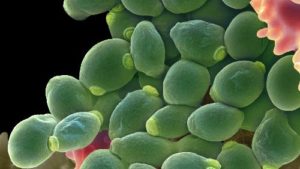 Shall we call them microflora or microfauna? That depends on whether you categorize them among the plants or the animals. And since the biologists don’t seem to be able to give an unambiguous answer, who are we to presume to know? All we can say for sure is that absent the vast, unseen and unremunerated labor force that yeasts comprise (and their ravenous appetite for grape sugars) wine would not and could not be. Yeasts, like those pictured above, needn’t bring their lunch to work. It’s there waiting for them.
Shall we call them microflora or microfauna? That depends on whether you categorize them among the plants or the animals. And since the biologists don’t seem to be able to give an unambiguous answer, who are we to presume to know? All we can say for sure is that absent the vast, unseen and unremunerated labor force that yeasts comprise (and their ravenous appetite for grape sugars) wine would not and could not be. Yeasts, like those pictured above, needn’t bring their lunch to work. It’s there waiting for them.
The tireless efforts of these mighty mites are what generate the alcohol that makes wine the stable, palatable, sweetly mood-enhancing beverage it is. Before Louis Pasteur peered into their mysterious little lives in the 1850’s we didn’t know yeasts existed; today we’re just beginning to glimpse the full extent of their contribution, and it goes far beyond begetting a buzz.
Presently, soils are the favored means of explaining the uniqueness of wine sites. Chances are good that you’ve heard a somm or retail clerk talk about how the slate or schist or chalk prevalent in the vineyard imparts a special character to the wine in question. Soils have a natural advantage in this respect, in part because of satisfying solidity they exhibit and the ease with which they can be differentiated. Exactly how how a rock can communicate something of its character through wine in the form of flavor and aroma is, however, not at all obvious.
By contrast, yeasts live surreptitious lives, invisible to the naked eye; impossible to turn over in the hand and examine.Their minuteness has always worked against their being credited with the amazing work they accomplish. Today we know that as many as half the volatile compounds responsible for how wine tastes and smells derive directly from yeast activity during fermentation.
But there’s enormous genetic diversity in yeasts, and a consequent variability in how they behave, producing different effects from winery to winery. This is consonant with the variation we note among varietally similar wines made in diverse places — exactly the outcome one would expect to see if place-specific strains of yeast were acting on grapes to produce place-specific wines.
The current view is that populations of yeasts capable of starting, maintaining and completing healthy fermentations are most likely to be found hanging out in wineries rather than in vineyards. If this is true, it’s easy to see how a stable, resident, self-selecting population of yeasts could establish itself inside a given cave or cantina where it would contribute in a predictable, ongoing way to the character of the wines that issue from it.
If winemakers had a choice in the matter, not every yeast would be given a work permit, though. Brettanomyces bruxellensis, for example, is a species that is particularly adept at producing what are called volatile phenols. The aromas it produces are reminiscent of barnyard smells, smoke, or bloody bandages — scents that can be engaging in small doses, but, when aggressive, result in faulty, offensive wines. It’s one of the reasons many winemakers opt for the predictable behavior of commercial cultured yeasts over feral varieties.
On a more positive note, recent research by enology professor Denis Dubourdieu at the University of Bordeaux has linked the production of sulfur compounds by specific yeast strains to those smoky, flinty notes that are so prized in, for example, Loire Valley Sauvignon Blanc. Such a finding strongly suggests that there is no longer any justification for attributing “stony” flavors and scents to the mineral content of the region’s soils. Geology, it appears, has been wrongly convicted on this charge.
Despite all this, most conversations about wine character continue to focus on soils, perhaps for no better reason than that rocks and dirt are so irresistibly present, while yeasts labor unseen and, like the stolid, unglamorous laborers they are, never sign their work. But if it turns out that soils contribute much less than we once thought to wine character, it won’t be the end of the world. The ground will always do at least one thing better than anything else can: Hold vines upright.